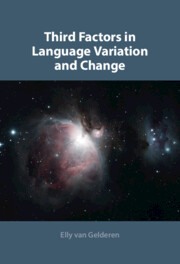Book contents
- Third Factors in Language Variation and Change
- Third Factors in Language Variation and Change
- Copyright page
- Contents
- Figures
- Tables
- Preface
- Abbreviations
- 1 The Shift towards a Minimal UG
- 2 Labeling in Language Change
- 3 Determinacy in Language Variation
- 4 Determinacy in Language Change
- 5 Labeling and Determinacy: Verb-Second and Expletives
- 6 Adjunct Incorporation and Avoiding Pair-Merge
- 7 Conclusion
- References
- Index
3 - Determinacy in Language Variation
Published online by Cambridge University Press: 16 December 2021
- Third Factors in Language Variation and Change
- Third Factors in Language Variation and Change
- Copyright page
- Contents
- Figures
- Tables
- Preface
- Abbreviations
- 1 The Shift towards a Minimal UG
- 2 Labeling in Language Change
- 3 Determinacy in Language Variation
- 4 Determinacy in Language Change
- 5 Labeling and Determinacy: Verb-Second and Expletives
- 6 Adjunct Incorporation and Avoiding Pair-Merge
- 7 Conclusion
- References
- Index
Summary
Chapter 3 considers how the Principle of Determinacy disallows certain constructions and what options are available to ‘fix’ these ungrammatical structures. Chomsky, Gallego, and Ott (2019) rule out having more than one choice in the workspace/phase, i.e. the workspace must be determinate. If a phrase moves from one position to another in the same phase, i.e. without being transferred/eliminated from the workspace, merge will face the dilemma of which of the two copies will move to a higher position. Determinacy is a third factor formulation of anti-locality and accounts for the Subject Island Condition and the ban on topicalization of the subject. The chapter focuses on how the CP–TP complex makes it hard for syntactic objects to move from the specifier of the v*P to the specifier of TP and then higher, to positions where they check the Q-features. Such a movement results in a that-trace violation. Deleting the C solves this problem and also explains subject-less relative clauses and complementizer-less object clauses in English. Other languages don’t posit a TP and solve the anti-locality problem that way. These languages lack that-trace effects but don’t delete the complementizer.
- Type
- Chapter
- Information
- Third Factors in Language Variation and Change , pp. 62 - 86Publisher: Cambridge University PressPrint publication year: 2021

